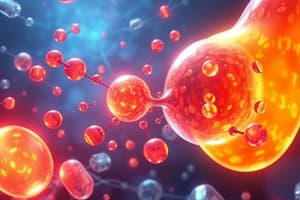Podcast
Questions and Answers
What is the primary reason for restricting the larger dose of acetaminophen?
What is the primary reason for restricting the larger dose of acetaminophen?
- Concerns about liver toxicity (correct)
- Risk of addiction
- Gastrointestinal side effects
- Inadequate pain relief
Why is acetaminophen often combined with an opioid analgesic agent for postsurgical dental pain?
Why is acetaminophen often combined with an opioid analgesic agent for postsurgical dental pain?
- To counteract the side effects of opioids
- To provide a synergistic effect for pain relief (correct)
- To increase the potency of the opioid
- To reduce the risk of opioid addiction
What is the rationale behind combining opioids with acetaminophen in dental pain management?
What is the rationale behind combining opioids with acetaminophen in dental pain management?
- To increase the potency of acetaminophen
- To reduce the dosage of opioids
- To reduce the risk of opioid addiction
- To provide a synergistic effect for pain relief (correct)
What is the main effect of NSAIDs on prostacyclin and thromboxane A2 synthesis?
What is the main effect of NSAIDs on prostacyclin and thromboxane A2 synthesis?
What is a significant advantage of NSAIDs over opioids in dental pain management?
What is a significant advantage of NSAIDs over opioids in dental pain management?
Why is acetaminophen not a good choice for reducing inflammation and pain?
Why is acetaminophen not a good choice for reducing inflammation and pain?
Which of the following is NOT a concern with using opioids in dental pain management?
Which of the following is NOT a concern with using opioids in dental pain management?
What is the rationale behind combining NSAIDs with acetaminophen?
What is the rationale behind combining NSAIDs with acetaminophen?
What is the primary mechanism of action of NSAIDs?
What is the primary mechanism of action of NSAIDs?
Three FDA-approved NSAIDs are:
Three FDA-approved NSAIDs are:
What is the advantage of combining opioids with NSAIDs or acetaminophen?
What is the advantage of combining opioids with NSAIDs or acetaminophen?
What is the main difference between COX-1 and COX-2?
What is the main difference between COX-1 and COX-2?
What is the result of combining 100 mg of enteric-coated diclofenac with 1000 mg of acetaminophen?
What is the result of combining 100 mg of enteric-coated diclofenac with 1000 mg of acetaminophen?
Which of the following NSAIDs causes irreversible inhibition of COX?
Which of the following NSAIDs causes irreversible inhibition of COX?
What is the main anti-inflammatory effect of NSAIDs due to?
What is the main anti-inflammatory effect of NSAIDs due to?
What is the ceiling effect observed with aspirin and acetaminophen?
What is the ceiling effect observed with aspirin and acetaminophen?
What is a characteristic of selective COX-2 inhibitors (Coxibs)?
What is a characteristic of selective COX-2 inhibitors (Coxibs)?
Which of the following is NOT a characteristic of non-selective COX inhibitors?
Which of the following is NOT a characteristic of non-selective COX inhibitors?
What is the primary mechanism of action of NSAIDs in combating pain?
What is the primary mechanism of action of NSAIDs in combating pain?
Why are NSAIDs preferred over opioid drugs for pain treatment?
Why are NSAIDs preferred over opioid drugs for pain treatment?
What is the maximum duration of consecutive dosing for pain, as per OTC package insert guidelines?
What is the maximum duration of consecutive dosing for pain, as per OTC package insert guidelines?
Why have some dentists started substituting acetaminophen for aspirin in postoperative dental pain treatment?
Why have some dentists started substituting acetaminophen for aspirin in postoperative dental pain treatment?
What is the primary advantage of combining NSAIDs with opioids in pain treatment?
What is the primary advantage of combining NSAIDs with opioids in pain treatment?
Which of the following NSAIDs has not been approved by the FDA for OTC use?
Which of the following NSAIDs has not been approved by the FDA for OTC use?
What is an advantage of combination analgesics for dental pain?
What is an advantage of combination analgesics for dental pain?
What is the mechanism of analgesia of salicylates?
What is the mechanism of analgesia of salicylates?
Which analgesic is best prescribed for a child with dental pain and febrile viral illness?
Which analgesic is best prescribed for a child with dental pain and febrile viral illness?
What is a common adverse reaction of salicylates?
What is a common adverse reaction of salicylates?
What is the primary use of combination analgesics in dentistry?
What is the primary use of combination analgesics in dentistry?
How do salicylates interact with other drugs?
How do salicylates interact with other drugs?
Flashcards are hidden until you start studying
Study Notes
NSAIDs in Dentistry
- NSAIDs inhibit prostacyclin (PGI2) synthesis, which may increase the risk of cardiovascular events.
- NSAIDs are often the first choice for pain relief in dental practice due to their anti-inflammatory efficacy.
Combination Analgesics for Dental Pain
- Aspirin and acetaminophen are sometimes combined, but a ceiling effect occurs when the total amount approaches 1g.
- Combining an NSAID with acetaminophen has some justification, as seen in the superior analgesic effect of 100mg diclofenac with 1000mg acetaminophen in impacted third molar surgery.
Opioid and Non-Opioid Analgesics
- Combining NSAIDs or acetaminophen with opioids has a sound scientific basis, as they invoke different, complementary mechanisms of pain relief.
- NSAIDs combat pain by interfering with biochemical mediators, while opioids alter CNS perception and reaction to pain.
Efficacy and Safety Profile of NSAIDs
- Short-term use of NSAIDs (≤ 1 week) has been highly efficacious and safe for pain and inflammation accompanying dental surgical procedures.
- NSAIDs lack undesirable CNS depressant effects seen with opioid-containing agents, leading to FDA approval for OTC use.
FDA-Approved NSAIDs
- Ibuprofen
- Naproxen
- Ketoprofen
Rationale of Opioids and Acetaminophen Combination
- Combining opioids with acetaminophen is rational due to different, complementary mechanisms of pain relief.
Advantages and Drawbacks of Combination Analgesics
- Advantages: superior analgesic effect, complementary mechanisms of pain relief
- Drawbacks: ceiling effect, potential for adverse reactions
Mechanism of Analgesia of Salicylates
- Salicylates inhibit cyclooxygenase (COX) enzyme, responsible for prostaglandin biosynthesis.
- COX-1 is constitutive, found in most tissues, while COX-2 is induced during inflammation.
Child with Dental Pain and Febrile Viral Illness
- Acetaminophen is often prescribed for dental pain in children due to its minor anti-inflammatory effects and lower risk of adverse reactions.
NSAIDs in Dentistry: Intended Learning Outcomes
- Be familiar with the pharmacology of NSAIDs.
- Identify the implications of NSAIDs in dentistry.
- Know how to manage dental pain by NSAIDs.
- Know the hazards of NSAIDs in long-term pain management.
Studying That Suits You
Use AI to generate personalized quizzes and flashcards to suit your learning preferences.



